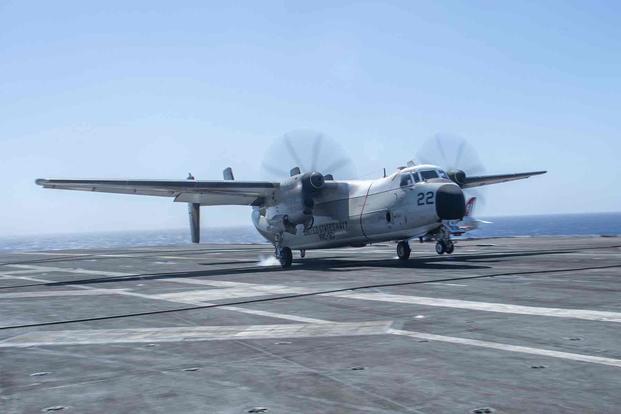SAN DIEGO -- The Navy's top aviation officer said the grounding of the V-22 Osprey has forced him to tap into his remaining C-2 Greyhound aircraft in order to keep aircraft carriers in the Pacific and the Middle East supplied and operational.
"Lucky for the Navy that the C-2 Greyhound is still available," Vice Adm. Daniel Cheever told a crowd at a panel discussion at the annual WEST 2024 conference Tuesday.
Cheever said the sea service has seen "limited operational impact at this point" from tapping the Greyhounds to fill its needs, but that there will be "significant operational impacts" in the future if the Osprey isn't returned to service following a grounding across the Navy, Air Force and Marine Corps that resulted from a Nov. 29 crash in Japan that killed eight airmen.
The Greyhound has been a staple of aircraft carrier life for decades. Cmdr. Beth Teach, a spokeswoman for Cheever, said in an email that the aircraft has been in service for 60 years, but the Navy is planning to retire it entirely by 2026.
For now, though, the last remaining squadron of 15 Greyhounds "is currently surging to meet the Carrier Onboard Delivery mission for deployed aircraft carriers in U.S. 5th and 7th Fleets," Teach confirmed.
The Osprey has been barred from flying for 69 days now after the deadly crash.
Military.com learned last week that Pentagon safety officials are talking with the Air Force, Marine Corps and Navy about the potential risks involved with flying the Osprey again. The status of the current Defense Department probe, what prompted officials to start talking with the services, and a possible timeline for putting the V-22 back in the air are still unknown.
The head of the Air Force's special operations command told reporters Tuesday that there are "conversations going on at multiple levels" about getting the Osprey flying again but added that there are no new findings or timelines to report.
Meanwhile, the impact for the Marine Corps is far more serious.
Lt. Gen. Karsten Heckl said that the Corps has seen "dramatic impacts" from the flying halt. Heckl noted that operations for three Marine expeditionary units, or MEUs -- including the 26th MEU currently on deployment with the Bataan Amphibious Ready Group in the Mediterranean -- have been affected.
The Greyhound surge comes amid the Navy's efforts to remove the aircraft from service entirely. The service has stopped training new pilots and is beginning to halt the purchase of supplies and parts for the aircraft.
"It's been the workhorse for years and years and years," Cheever said. "They're not sundowned yet so we're maintaining that capability and capacity as we go through this [grounding]."
Related: Spate of Osprey Mishaps, Including Air Force's Most Deadly, Will Be Investigated by Federal Watchdog













